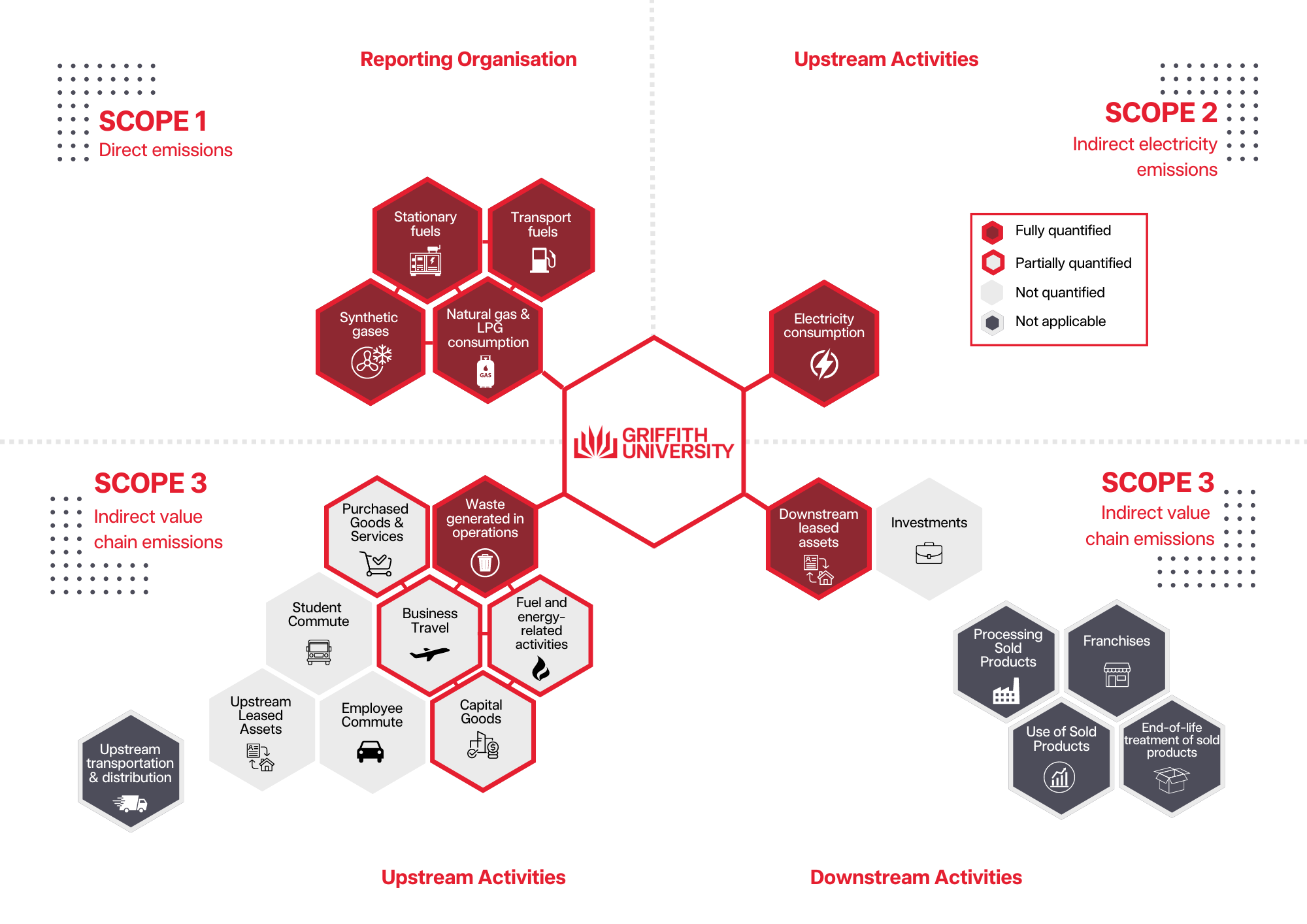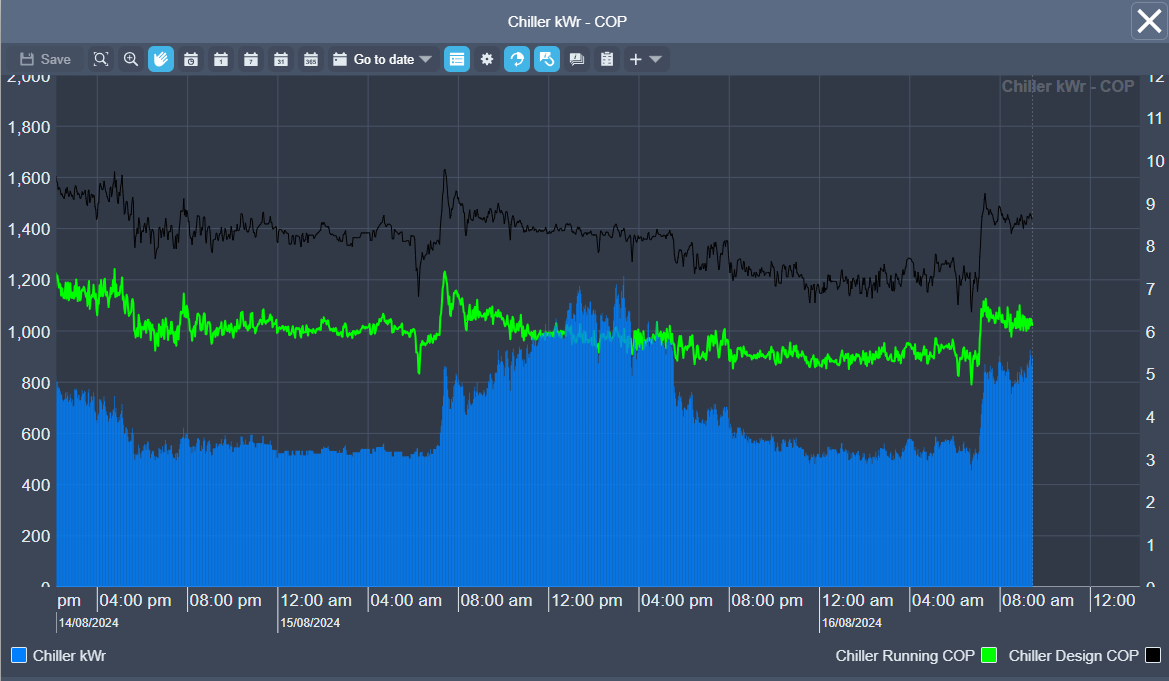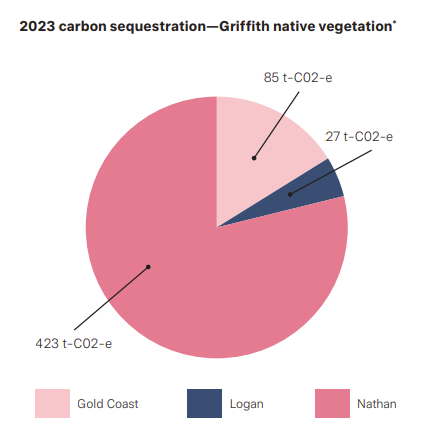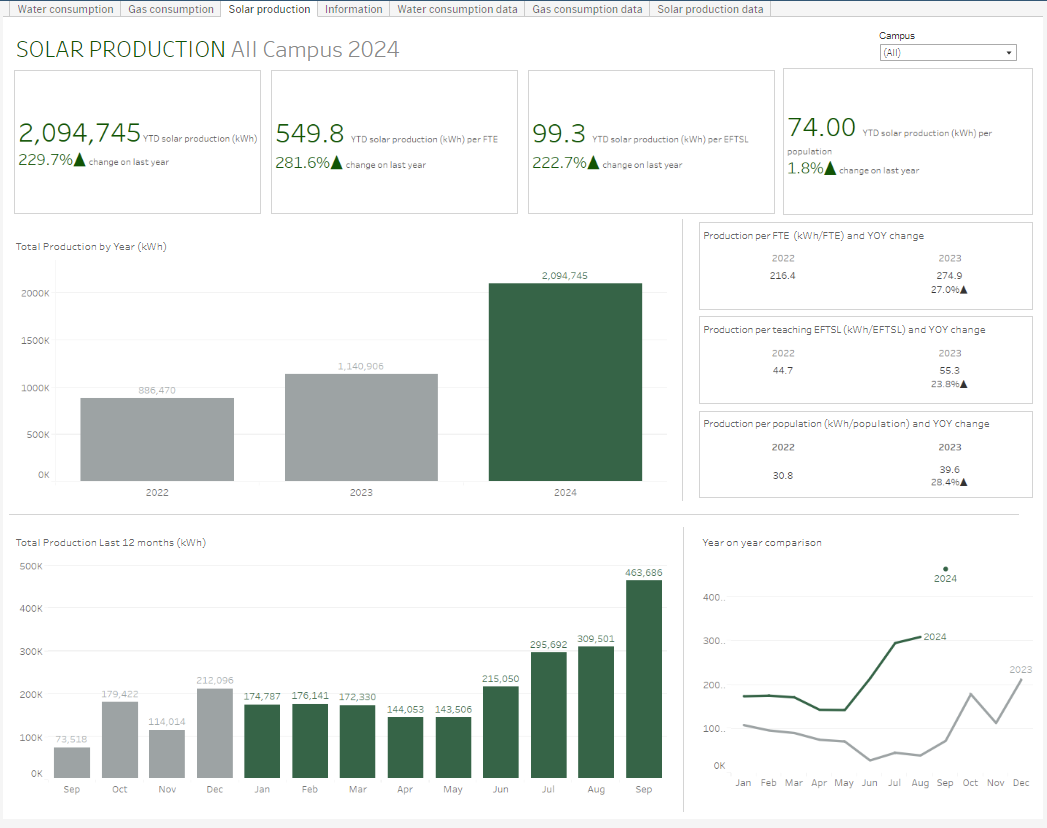In 2022, Griffith University committed to achieving net zero emissions by 2029 based on a defined emissions boundary (see below).
As part of this commitment, the university pledges to commit to purchasing 100% renewable energy by 2029. It also advocates for others to make similar pledges to move towards renewable energy sources.
In considering measures to manage emissions the University will continue to follow an established mitigation hierarchy, be transparent and additional to existing strategies. Actions that avoid emissions will be prioritised wherever feasible, followed by those that that minimise emissions that cannot yet be avoided. Onsite renewables (e.g. rooftop solar) will be prioritised over the purchasing of offsite renewable energy. There will be a quantum of residual emissions which will then need to be compensated for, to ensure we are carbon neutral by 2029.
Griffith University’s established emissions mitigation hierarchy
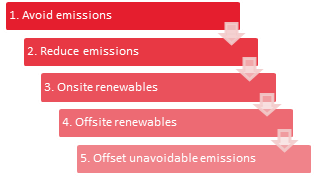
Sustainable Development Goals
Griffith University is aligned with the United Nation's Sustainable Development Goals ( SDGs ) and committed to tackling global challenges around climate action.
Griffith University's contribution to global net zero emissions (NZE)
Net zero emissions (NZE) has various meanings depending on scale and context. On a global scale and from a scientific perspective, NZE will be reached when total anthropogenic emissions (the sum of fossil fuel and land use emissions) are reduced to levels that match the removal capacity of the natural sinks (i.e., terrestrial ecosystems and oceans). At sub-global scales (i.e. at a national or organisation level) NZE is commonly used when referring to achieving a ‘net zero’ result in inventory accounting terms. At an organisation level, this is typically achieved through a combination of avoiding and minimising emission reductions and purchasing carbon offset credits.
Recognising this, Griffith University is doing the uttermost to contribute to national and ultimately global targets, above and beyond its NZE commitment. It is working to ensure that only residual emissions will be compensated to meet its NZE 2029 commitment and that any use of offsets is progressively reduced over time as solutions for hard to abate emissions are realised. A position of compensating a maximum 5% residual emissions (5% of the 2010/11 baseline year excluding aviation emissions) plus any remaining aviation emissions1 by 2029 has been agreed, with further detailed work required, especially with relation to aviation emissions, to develop a detailed compensation plan to ensure environmental and social integrity.
Emissions boundary
A greenhouse gas emissions boundary defines the emission sources that are included in an organisation's carbon inventory. Griffith University’s emissions boundary was set in 2008/9 based on the Greenhouse Gas Protocol and includes all scope 1 and scope 2 emissions and partial scope 3 emissions.
Scope 1 emissions are generated on our campuses, or associated with the University’s business, generated through the combustion of fossil fuels in university-owned vehicles, natural gas and LPG use as well as synthetic gases such as refrigerant gas leakages. Scope 2 emissions are associated with the use of electricity imported from the grid or from a third-party supplier of energy in the form of heat or electricity.
Scope 3 emissions are a direct consequence of the use of goods or services provided to the University to enable it to conduct its business. There are 15 Greenhouse Gas Protocol categories for scope 3 emission sources but not all of these are relevant to the tertiary education sector and Griffith currently reports emissions under Category 1, 2, 3, 5 and 6. Sources within the University's boundary include waste disposal, cleaning services, food and beverage services, IT and other equipment, paper, flights, and transmission and distribution losses from electricity. This omits, for example, emissions from construction, ‘work from home’ activities and employee and student commuting. It also omits aviation emissions for international education (enrolments, transnational education, and inbound and outbound student travel).
Action areas
The pathway towards achieving the University’s net zero emissions goals employs the following key actions:
| Pillar | Action area | Action |
|---|---|---|
| Net zero by 2029 (scope 1, 2 and partial 3) | Carbon footprint reduction | Improve energy efficiency (infrastructure and equipment) |
| Reduce aviation emissions | ||
| Reduce non-aviation transport emissions | ||
| Reduce waste emissions | ||
| Renewable energy use | Increase on-campus renewable energy generation | |
| Increase proportion of off-campus renewable energy | ||
| Accounting and reporting | Enhance energy accounting and reporting | |
| Residual emission compensation | Determine offsetting position and compensation plan |
Reducing Griffith’s carbon footprint through carbon and emission reduction processes
Griffith is taking multiple actions to reduce our energy consumption and carbon emissions including a clear process for carbon management and reporting (see our 2024 Carbon Management Report), while also reducing carbon dioxide emissions. This is achieved through energy-efficient renovations and buildings, upgrading buildings to higher energy efficiency, data centre efficiency, aviation emissions reductions, powering Griffith through clean, renewable energy, carbon sequestration on campus, and sustainable transport for staff and students.
Sustainable transport for staff and students
Griffith University encourages staff and students to use sustainable transport, including the University’s intercampus buses, cycling, walking, public transport or video conferencing.
Find out more about commuting sustainably to Griffith here:
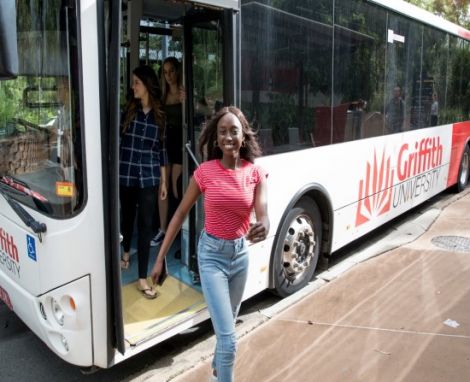
Public transport and intercampus bus
All our campuses are serviced by public transport, which is managed by TransLink. This is the most efficient and cost-effective way to travel to campus as it only costs 50 cents!
Our intercampus bus travels every 15 minutes between Brisbane South (Nathan) and Brisbane South (Mt Gravatt) and the Student Guild Intercampus Bus travels between Gold Coast and Brisbane South (Nathan).

End-of-trip facilities
Cycling is a healthy and cost-effective way to get to campus. It reduces greenhouse gas emissions and traffic congestion.
Bike racks and end-of-trip facilities are available across our campuses. End-of-trip facilities include lockable bike shed, showers and lockers for personal belongings (such as your bike helmet).

University vehicles
The University’s Fleet vehicle booking service includes the option to 'Share a Ride' with other colleagues. Visit the Fleet site, select the date and destination, match your travel requirements and contact the relevant driver. If travelling, schedule meetings and appointments to occur during the one trip.
Since July 2016, the University has taken delivery of 65 hybrid vehicles, nine electric utility carts and one electric vehicle, as part of a strategy to replace all conventional petrol cars in the pool fleet with more environmentally friendly alternatives. EV charging stations are available at Gold Coast and Brisbane South (Nathan). For more information about where to find charging stations and other transport options, please visit Transport and Parking.
Contact Griffith Sustainability
Griffith Sustainability Room 2.40, Building N54, Griffith University, 170 Kessels Road, Nathan QLD, 4111
